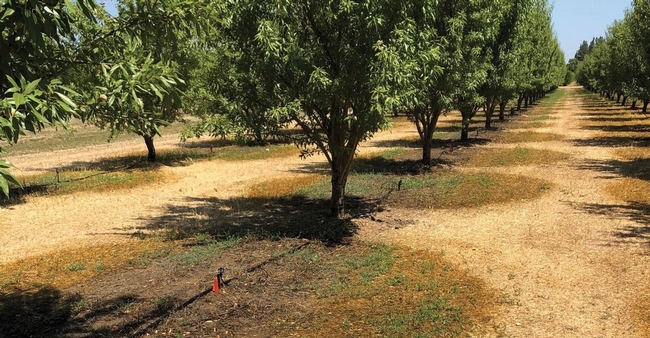From the Tree Nut Farm Press :: Feb. 17, 2021
Weed management is important even in offseason
Lee Allen | Feb 17, 2021
It's a never-ending task to keep weeds under control.
It's a never-ending task to keep weeds under control, as post-harvest and dormant weed management are just as important as during the unruly spring and summer months.
“In our Mediterranean climate, cooler weather is when we have lots of weed pressure in the orchard systems, so from my perspective, a good weed management season in a tree nut orchard should starts right after the previous harvest,” said Brad Hanson, a cooperative extension specialist and member of the University of California, Davis Department of Plant Sciences.
In fact, it starts as soon as nuts get shaken from the trees and scooped up from the ground. “That's when you start thinking about next year's weed control --- what weeds do you have in the orchard and what problems you had in the year ending in order to design a program to address those problems the following season,” Hanson said.
Current climate conditions notwithstanding, tradition has it that cooler and shorter days follow the harvest with the arrival of rain. “That's when you'll start to see the onset of the heaviest weed press in the form of annual offseason weeds,” he said. “You want to get out ahead of that first flush.”
Soil type and rainfall patterns help determine the varieties of weeds in a geographic area. “The primary ones I see are winter grasses like ryegrass, bluegrass, filaree, and maybe chickweed, particularly in the northern part of the central valley.”
How you fight weed infestations depends a lot on your locale rather than a Step 1-2-3 program. “When the first rains come and how frequently they show up drives weed pressure, so management is based on a thoughtful approach involving field scouting and weed identification,” Hanson said. “You need to know just what it is you're trying to control and what your orchard's tolerance for weeds might be. Maybe you can tolerate some kinds of weeds, but want to make a good effort to control others.”
Hanson advocates what he refers to as a thoughtful approach, i.e., integrated weed management. “I've been going around the state the last several years where growers traditionally resolved problems by adding more herbicides to the mix because they could afford to and because they had a low tolerance for weeds,” he said. “I'm of the belief we may be over-treating and not using the other tools we have to their best ability. It's using a bigger hammer than you need to and that may not always be the best approach. Wild swings with a sledgehammer aren't necessarily better than a more prescriptive approach.”
A two-application program
Herbicide-managed tree nut orchards use at least a two-application program, a burn-down in the spring following any winter pre-emergent program.
“We need to use our tools better, a more directed application to achieve management of a specific weed problem, maybe having used a full rate of herbicide in December, then perhaps half that much in March, specifically targeting emergent weeds that appear in April-May-June. What that amounts to is using half as much herbicide by using it at a better time.”
Asked if there was anything new in the world of weeds, Hanson paused before saying: “There's not anything groundbreaking across all tree nut orchards in the state. There are areas that have some unusual weed problems that are harder to control, like in the San Joaquin Valley where some weeds are proving resistant to control with cornerstone herbicides, but that's been a story for quite some time. I don't see anything earth-shattering although some of the newer items like flea bane or alkali weed might be problematic.”
Bottom line when it comes to weed problems is what he calls prescriptive management involving vigilance. “You have to become better at what you do with the tools available because a good manager will always get better weed control.”
For more news on tree nuts as reported by growers and farm advisors, subscribe to the Tree Nut Farm Press e-newsletter.
